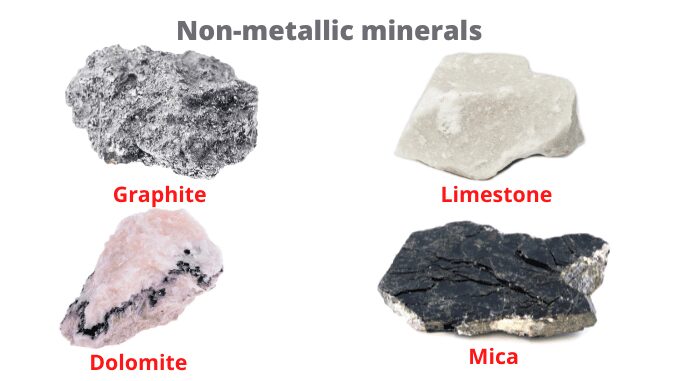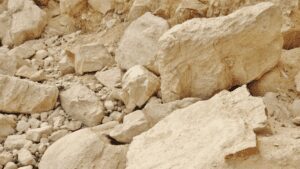
Introduction
Minerals are inorganic elements that are naturally occurring. They have a specific internal structure and chemical composition. That is they are are having their own chemical and physical properties. Some examples of minerals are quartz, mica, and calcite. It is broadly classified into two categories, such as metallic minerals and non-metallic minerals. Below is a discussion of non-metallic minerals, differences, and definitions.
Let’s see what minerals are and their importance before discussing non-metallic minerals. Modern machinery is totally dependent on mineral resources. Relying on minerals, man has reached space and at the same time reached the pinnacle of human civilization.
The extraction and use of minerals have been going on since ancient times. Extensive use of these resources dates back to the time of the industrial revolution. The development of industry started around the minerals, that is, the economic development of the country. So minerals are very important and essential.
Minerals are usually extracted from the top and bottom of the earth’s surface. For example, coal, iron ore, copper petroleum, etc. are extracted underground, and salt, limestone, etc. are extracted from the top of the surface. Mainly two types of minerals are extracted from the bottom and the top of the surface. Non-metallic minerals are one of them (1) & (4).
Non-metallic minerals definition
A type of mineral that has low densities, does not have any shining surface, and has less conductive power of heat and electricity. Also, does not yield any metals when molten, is known as a Non-metallic mineral (5).
Description non-metallic minerals
1. Features
1. Most of the non-metallic minerals are generally soft except, sulfur and phosphorus. But one non-metallic mineral carbon (in the form of the diamond) is very hard.
2. These minerals cannot conduct heat and electricity.
3. They have low melting points and boiling points except, for diamonds. The melting point of the diamond is however more than 3500°C, which is very high.
4. This type of mineral does not have luster. It means this type of mineral does not have a shining surface.
5. They are neither malleable nor ductile. These types of minerals are brittle. These types of minerals break into pieces when hammered or stretched.
6. Are non-sonorous. They do not produce sound when they are hit by other objects.
7. They are solid, liquid, and gaseous at room temperature.
8. These types of minerals are not strong. They are easily broken.
9. These minerals have many different colors.
10. These types of minerals have low densities, that is these types of minerals are light (1) & (5).
2. Classification
According to use, there are four types of non-metallic minerals in nature. These are
1. Minerals used for fuel purposes
Such non-metallic minerals are coal, mineral oil, natural gas, uranium, etc.
2. Minerals used in architecture
Marble, limestone, granite, gypsum, etc. are these types of non-metallic minerals.
3. Minerals used in the chemical industry
Potash, Sulphur, dolomite, phosphate, etc. are non-metallic minerals used in the chemical industry.
4. other types of minerals
Porcelain, mica, graphite, etc. (2) & (4).
Non-metallic minerals Vs Metallic minerals
Non-metallic minerals
They are naturally composed of a combination of chemical elements that lack most metallic properties. These minerals are mainly composed of carbon. For example, coal is basically composed of naturally occurring carbon (3).
Metallic minerals
Metallic minerals are the only minerals that have one or more metallic substances. They usually have glossy surfaces, conductors of heat and electricity, and can be expanded into thin sheets. When metallic minerals are mined, they are known as ores and ores should be further improved to separate the metals. First, the ore is crushed and then the metallic minerals are separated from the rock (3).
Differences
A review of the physical and chemical properties of metallic and non-metallic minerals shows that there are some differences between them. These differences are illustrated below.
Content |
Non-metallic minerals |
Metallic minerals |
1. Meaning |
Can not generate new compounds when heated and are not metals basically. | Metallic minerals are types of minerals that are made up of one or more metals. |
2. Hardness |
Non-metallic minerals are generally soft. | Most of the metallic minerals are hard. |
3. Malleability |
They are not malleable or flexible. | Malleability is an important characteristic of metallic minerals. Most of the metallic minerals are malleable. |
4. Heat and electricity |
Non-metallic minerals cannot conduct heat and electricity. They are the insulator of heat and electricity. | On contrary, they are capable of transporting heat and electricity. Their heat and electricity conductivity is much higher than that of non-metallic minerals. |
5. Melting and boiling point |
The melting and boiling power of non-metallic minerals are less than that of metallic minerals. | Metallic minerals have high melting points and boiling points. |
6. Produced sound |
They do not produce a metallic sound when they hit. | Hitting metallic minerals produces a metallic sound. |
7. Ductility |
Non-metallic minerals are not ductile. They break into pieces when hammered or stretched. | Metallic minerals are ductile. |
8. Density |
Have low densities, that is non-metallic are light substances. | Metallic minerals have a high density and are very heavy. |
9. Produced new products |
They do not form any new substances or metals during melting. | Metallic minerals form other metals during the melting process. |
10. Examples |
Salt, coal, clay, mica, etc. | Iron ore, copper, manganese, tin, bauxite, etc. |
11. Luster |
No luster in Non-metallic minerals. They do not have any shining surface. | Metallic minerals are luster. They have a shining surface. This shiny appearance makes them useful in making jewelry. |
12. Origin |
They originate from sedimentary rocks (2) & (5). | Originate from igneous rocks and metamorphic rocks. |
Similarities
In addition to the above differences, some similarities exist between non-metallic and metallic minerals. These are as follows
- Both are composed of organic and inorganic elements.
- The availability of these two types of minerals depends a lot on the rock and the climate.
- Metallic and non-metallic minerals are formed through long-term processes in nature.
Non-metallic minerals examples
Some examples of non-metallic minerals are
Mica
Mica comes from the Latin word ‘micare’, which means shiny. It is found mainly in sedimentary rock. Sometimes it is also found in igneous and metamorphic rock. Large crystals of mica are used for various purposes and are specially mined from granite and pegmatite.
- Ore of mica
- Muscovite or potash mica
- Biotite
- Phlogopite
- Lepidolite
- Paragonite
- Producer country
Most mica-producing countries use most mica to meet their own needs. India, Brazil, Argentina, Russia, Canada, South Korea, the USA, etc. are the exporter countries of mica. Japan, the United Kingdom, France, and Germany are the importer countries of mica. The largest mica producer in the world in 2021 was china. India produces about 60% of the world’s mica. In India, mica mines are located in Jharkhand, Rajasthan, and Andhra Pradesh.
- Uses
- Sound devices like radios, telephones, televisions, etc.
- The receiver of the radio.
- Mica is used to creating colors. In addition, gulal is made attractive by mixing mica powder with gulal.
- Extinguishing the fire as it is non-flammable.
- Mica powder is mixed with rubber to make the wheel of the car much stronger.
- Electric irons, heaters, etc.
Limestone

The chemical name of limestone is calcium carbonate (CaCO₃). Pure limestone is rarely found in nature. The hardness of limestone is 3.0 and its relative weight is 2.6 to 2.8. Limestone can be formed in both organic and inorganic processes. Most limestones are rich in high levels of fossils. About 10% of sedimentary rocks are limestone.
In India limestone is produced in Rajasthan, Madhya Pradesh, Andhra Pradesh, Gujrat, Tamil Nadu, Maharashtra, Himachal Pradesh, Chhattisgarh, Telangana, Karnataka, etc.
Uses
- Make lime.
- The main component of cement is limestone.
- Construction, chemical, and glass industries.
- Metal extraction and in the sugar industry.
Magnesite
Magnesite is a non-metallic mineral. It has no melting and boiling point. The word magnesite comes from ‘magnesia’. Its chemical compositions are 47.6% MgO and 52.4% CO₂. Magnesite is found as a coarse-grained lump that looks a lot like cauliflower. It is mainly white in color.
Uses
- Metallurgical engineering as a thermal insulator.
- Raw material for making cement.
Gypsum
Gypsum is a soft sulfate mineral. Its color is white. Its chemical formula is CaSO₄. 2H₂O. Gypsum is a malleable mineral. These minerals are slowly dissolved in water. Gypsum does not react with acids but dissolves in hydrogen chloride.
Uses
- Special types of chalk.
- Plastering.
- Raw material for making cement.
- Agriculture as fertilizer.
- Plants receive Sulphur and calcium ions from gypsum (4) & (5).
Non-metallic minerals list
Gypsum, mica, Sulphur, dolomite, fluorspar, barite, calcite, quartz, diamond, sand, graphite, apatite, cryolite, celestite, magnesite, talc, feldspar, corundum, garnet, tripolite, clay, salt, potash, silica, fireclay, jasper, shale, pyrophyllite, ochre, kaolin, diaspore, felsite, chalk, fusch quartzite, slate, etc. are these types of minerals (2).
Q&A
1. What are two ways non-metallic minerals can be used
Two ways of using non-metallic minerals are
- For the production of industrial cement, ceramics, and glass products.
- In chemical industries, and as fertilizers like gypsum.
2. What are non-metallic minerals?
They are minerals that release various non-metals during smelting.
3. What are some uses of non-metallic minerals?
- Construction, chemical, and glass industries.
- Extinguishing the fire.
- Agriculture as fertilizers.
- Sugar industry.
4. What are some examples of non-metallic minerals?
Gypsum, mica, Sulphur, dolomite, fluorspar, barite, calcite, quartz, diamond, sand, graphite, etc. are some examples of these types of minerals.
5. What is the definition of non-metallic minerals?
Minerals that do not release any metals when molten.
Written By: Manisha Bharati
